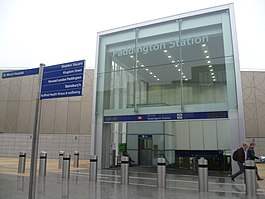Paddington tube station (Circle and Hammersmith & City lines)
| Paddington |
|
|---|---|

Entrance from Paddington Basin
|
|
|
Location of Paddington in Central London
|
|
| Location | Paddington |
| Local authority | City of Westminster |
| Managed by | London Underground |
| Number of platforms | 2 |
| Accessible | Yes |
| Fare zone | 1 |
| OSI |
Marylebone NR Lancaster Gate |
| London Underground annual entry and exit | |
| 2012 |
|
| 2013 |
|
| 2014 |
|
| 2015 |
|
| Key dates | |
| 1863 | Opened (as terminus) |
| 1864 | Extension (to Hammersmith) |
| 1872 | Started ("Middle Circle") |
| 1905 | Ended ("Middle Circle") |
| 1990 | Started (Hammersmith & City) |
| 2009 | Started (Circle line to Hammersmith) |
| Other information | |
| Lists of stations | |
| WGS84 | 51°31′07″N 0°10′42″W / 51.518578°N 0.178470°WCoordinates: 51°31′07″N 0°10′42″W / 51.518578°N 0.178470°W |
|
|
|
Paddington is a London Underground station served by the Circle and Hammersmith & City lines. It is located adjacent to the north side of Paddington mainline station and has entrances from within the mainline station and from Paddington Basin. The station is between Royal Oak and Edgware Road and is in London Fare Zone 1.
The station is one of two separate Underground stations of the same name. The other station, on Praed Street to the south of the mainline station, is served by the Bakerloo, Circle and District lines. Although shown on the London Underground map as a single station, the two stations are not directly linked and interchange between them is via the concourse of the mainline station.
The station was opened as Paddington (Bishop's Road) by the Metropolitan Railway (MR, later the Metropolitan line) on 10 January 1863 as the western terminus of the world's first underground railway. The station building was located on the road bridge carrying Bishop's Road (now Bishop's Bridge Road) over the mainline tracks of the Great Western Railway (GWR). Services were initially operated with rolling stock provided by the GWR, and the MR route to Farringdon was laid with dual-gauge track for both broad-gauge and standard-gauge trains.
...
Wikipedia

